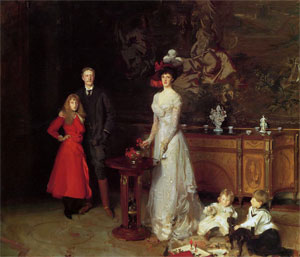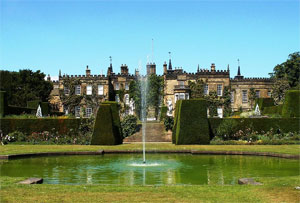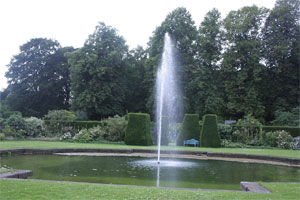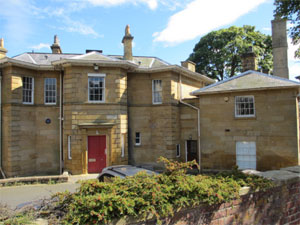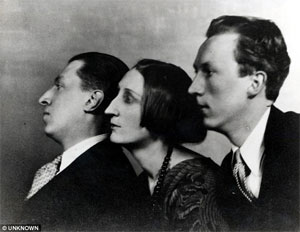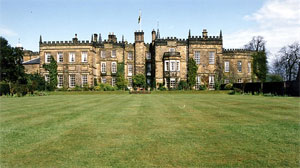Edith Sitwell, eccentric genius: A new biography of the avant garde poet Edith Sitwell is applauded by her great-nephew William Sitwellby William Sitwell
11 Mar 2011
NOTICE: THIS WORK MAY BE PROTECTED BY COPYRIGHTYOU ARE REQUIRED TO READ
THE COPYRIGHT NOTICE AT THIS LINK BEFORE YOU READ THE FOLLOWING WORK, THAT IS AVAILABLE SOLELY FOR PRIVATE STUDY, SCHOLARSHIP OR RESEARCH PURSUANT TO 17 U.S.C. SECTION 107 AND 108. IN THE EVENT THAT THE LIBRARY DETERMINES THAT UNLAWFUL COPYING OF THIS WORK HAS OCCURRED, THE LIBRARY HAS THE RIGHT TO BLOCK THE I.P. ADDRESS AT WHICH THE UNLAWFUL COPYING APPEARED TO HAVE OCCURRED. THANK YOU FOR RESPECTING THE RIGHTS OF COPYRIGHT OWNERS.
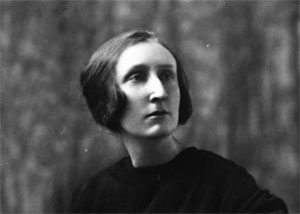
Edith Sitwell, 1931
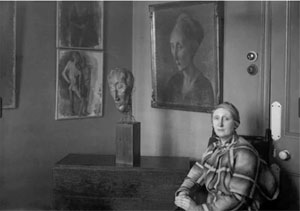
Edith Sitwell with a bust and a portrait of herself, 1931 Photo: Getty Images
It was a wet, wintry night on London’s South Bank that I first got to know my great-aunt Edith properly.
She had died in 1964, some years before I was born. But then, waiting in the wings of the Purcell Room, I breathed in deeply before taking to the stage to recite her Façade series of poems.
Set to music by William Walton, the poems are said, not sung, in precise time to the music. Some of the lines must be proclaimed at breakneck speed, and as I worked my way through the colourful, exotic language, the assonances and dissonances,
I could almost feel her spirit conjuring up the figures of Sir Beelzebub and Black Mrs Behemoth, not to mention the satyrs, nymphs and others who appear.She wrote this early white rap in the 1920s, finessing it over the next 40 years, and it demonstrates her extraordinary, dextrous touch with the English language, and her musical abilities.
More used to the comforts of an office, or better still a table in a restaurant – I work as a magazine editor and food critic – learning Façade had taken me on a year-long journey into the mind and life of Edith Sitwell. I had met some of her last surviving contemporaries, critics and champions of her work.
Now an even fuller picture of her emerges in the detailed, moving and often hilarious new book about her by the Canadian professor of English Richard Greene. The first biography of her for 30 years, using a wealth of previously unseen letters, it paints an extraordinary picture of childhood suffering, courageous writing and unrequited love. Greene makes an impassioned plea that 'It is time to look again at Edith Sitwell.’
She was born in 1887 to parents who could not have had less in common. Her mother, Lady Ida – daughter of the Earl of Londesborough; beautiful, gregarious and pleasure-loving – contrasted with her father, Sir George, in turn austere and solitary.
'The poor creature,’ Edith later wrote of her barely educated, then 17-year-old mother, 'married against her will into a kind of slave-bondage.’Winters and spring were spent in
Scarborough, where the family had a house near the seafront. The characters she saw there – minstrels, pierrots, contortionists – echo in her Façade poems, as do the elegant, empty-headed people who wandered at the seaside. Her poem Valse begins:
'Daisy and Lily,
Lazy and silly,
Walk by the shore of the wan grassy sea…’
The family then decamped for summer and autumn to Renishaw Hall, a gothic house on the edge of Chesterfield built by the Sitwells in the early 17th century when they had made a fortune as the world’s largest producers of nails (now lived in by my first cousin Alexandra Hayward and her family).It was another location that shaped Edith’s poetry and she recalled it as 'dark and forgotten… like an unopened 17th-century first edition in a library’. There, Lady Ida would start her day, as the biographer Sarah Bradford describes, '[lying] late in bed in a bedroom heavy with the scent of discarded gardenias and tuberoses, reading French novels, newspapers or letters, or playing patience on a flat-folding leather card-tray.’
Meanwhile Sir George would be cooped up in his study, smoking strong Egyptian cigarettes and pondering on his writing and thoughts. His literary output ranged between the eclectic and the bizarre:
The Introduction of the Peacock into Western Gardens, Rotherham Under Cromwell, Modern Modifications on Leaden Jewellery in the Middle Ages and his seminal A Short History of the Fork – an epic tome that competes for brilliance with the results of his analysis for curing insomnia entitled The Twenty-Seven Postures of Sir George R Sitwell.He installed a notice at Renishaw that read: 'I must ask anyone entering the house never to contradict me in any way, as it interferes with the functioning of the gastric juices and prevents my sleeping at night.’
Sir George’s approach to procreation was equally eccentric. In order to achieve the finest result he would read a worthy tome before declaring, 'Ida, I am ready.’ He saw his sons as being a vital extension of his personality, events to enhance the Sitwell line, and it never occurred to him that his first-born might be a girl. Thus, as Edith recalled, 'I was unpopular with my parents from the moment of my birth.’
Her arrival deepened the rift between her parents; when her brothers, Osbert and then Sacheverell, were born, with much fanfare, she was relegated to a back place in the nursery and was put, as she wrote, 'in disgrace for being a female’.
She had more affection for her maternal grandfather, although he died in 1900 after contracting pneumonia from a parrot. And while she was entertained by her mother’s relations, who had a penchant for practical jokes – tethering hens under people’s beds and hiding live lobsters between the sheets – she was repulsed by their obsession with shooting. Memories of gamekeepers releasing rabbits from sacks to be shot or beaten with sticks made her a life-long campaigner against blood sports.The remoteness and eccentric behaviour of her father and the increasingly sick and drunken rages of her mother stayed with Edith for the rest of her life. Years later she wrote to Osbert of her 'terrible childhood and… appalling home. I don’t believe there is another family in England who have had parents like ours.’
In my search to speak to surviving contemporaries I came across Lady Natasha Spender (who died last October aged 91), the widow of the writer Stephen, who in the study of her north London home revealed the extraordinary extent of Edith’s suffering.
'She was frightened of her parents, who were so belligerent and remote,’ she recalled. 'They gave her absolute hell and would punish her. She would go out for a walk and come in quietly through a side door, and the butler would lock her in the silver pantry until he thought it safe for her to emerge. It was like benign protective custody.’
The children bonded instead with the servants, in particular with Henry Moat, 'an enormous purple man like a benevolent hippopotamus,’ Edith wrote. Born to a family of whalers in Whitby, he had 18 brothers, one sister and a tame seal. He worked for the family for 43 years, although he was sacked and then cajoled back frequently, and as butler became almost inseparable from Sir George.Described by Richard Greene as the 'Sancho Panza to Sir George’s Don Quixote’, he would explode his master’s more outlandish schemes.
'Henry,’ Sir George once called to his butler, 'I’ve a new idea. Knife handles should always be made of condensed milk.’
'Yes, Sir George,’ Moat replied, 'but what if the cat gets at them?’
Edith continued into her teens, hiding from governesses and, by her account, reading and learning poetry in secret while her father, worried about her posture, engaged an orthopaedic manufacturer who designed a torturous – albeit laced – iron spinal apparatus. This she was forced to wear along with a terrifying nose-truss to improve her profile.So obsessed was Sir George with her nose that when he commissioned the artist John Singer Sargent to paint the family in 1900 he made a point of asking the painter to portray its deviations in correct detail.
Sargent was so appalled at this request that if you look closely at the painting you can see he painted Edith’s nose as a fine, straight specimen while adding a distinct crook to that of her father. Indeed the painting portrays Edith as more assertive and confident than she actually was. Dressed in scarlet, she commands attention from the canvas.
It was at a point in her life when 'finishing’ was the norm, or 'finishing off’ as Edith put it. She was taught what she described as 'the heavy art of light conversation’. The lessons came to nothing and, aged 17, seated next to a politician and huntsman, she asked him if he preferred Bach to Mozart and was, she recalled, hastily 'withdrawn from circulation’.
Undeterred, she was attracted to the arts and spent hours transcribing poetry before being encouraged to write by a cousin, Joan Wake. With the outbreak of war and the shelling by German warships of the Sitwells’ house in Scarborough, Edith moved to London, her mind set on a life as a writer, renting a flat in a poor but lively spot in Bayswater.
But if she thought she could escape her family, she was wrong, as they were suddenly engulfed in scandal.
Having got into tremendous debt about which she was afraid to tell her husband, Lady Ida became tangled up with unscrupulous moneylenders. Sir George, determined to do the 'right’ thing and see the culprits get their comeuppance, refused to deal with the matter out of court and the affair was resolved in the Old Bailey. The shocking end to the story being that in 1915 Lady Ida found herself convicted of fraud and sent to Holloway prison for three months.'How did it feel when your mother went to prison?’ Stephen Spender once asked Edith.
'Not altogether pleasant,’ she replied. 'Because, you see, in those days one did not go to prison.’
The sentence was such a shock that no one remembered to tell Sacheverell, my grandfather. And so one weekend while studying at Eton, he saw on the front page of the Sunday Express that his mother had been jailed.Perhaps the events galvanised Edith. Shortly after, her first poem – written on notepaper from Courtenhall, the family home of Joan Wake – was published in the Daily Mirror. Soon she had paid to have five poems published, and although a slight volume at only 10 pages, it was reviewed in the Times Literary Supplement in glowing terms: 'Sitwell does not describe, she lives in her verse.’
Her name spread and before long she started hosting literary salons, something that was to last for many decades. She published a regular anthology of poetry called Wheels, in which she promoted the talents of the likes of Aldous Huxley and Wilfred Owen. And she fell in love.This first unconsummated affair was with a Chilean artist, Alvaro de Guevara, whose brother, Richard Greene notes, had gone mad, stabbed himself and then leapt to his death from a house in South Kensington, clutching an umbrella as a parachute. Edith claimed they been engaged until she was warned that he suffered from a serious venereal disease.
It’s an idea that the writer Harold Acton dismissed, saying rather cruelly that Edith was a 'sex-starved spinster all her life. She desperately needed someone to take her to bed, but I’m sure that no one ever did. Certainly if it did happen, which I doubt, he was an extremely courageous gentleman… dear Edith wasn’t exactly what you might call cuddly.’
Aged 70, she wept to her secretary Elizabeth Salter that she had never had a passionate relationship, but it is impossible, unnecessary even, to know. Or as one biographer put it: 'Edith was returned unopened.’While her reputation as a poet gained in stature, she embarked on the more controversial and avant garde project of Façade. Osbert had suggested that a friend of Sacheverell’s from Oxford called William Walton, an as-yet-unknown organ scholar from Oldham, set some of her poems to music. (He may also have given her some rhythms to work with.)
With a small orchestra of some seven musicians, the first public performance at the Aeolian Hall in London, with Edith reciting through a Sengerphone (an early megaphone), was, as she recalled in her autobiography, 'anything but peaceful. Never, I should think, was a larger and more imposing shower of brickbats hurled at any new work.’The critics were savage. 'Drivel they paid to hear’ was one headline. Another paper remarked, 'Last night at the Aeolian Hall, through a megaphone we heard Edith bawl.’ As Osbert later commented, 'For several weeks subsequently we were obliged to go about London feeling as if we had committed a murder.’
Noël Coward, who had ostentatiously walked out during the performance, now parodied the Sitwells in a West End show called London Calling that featured the 'Swiss Family Whittlebot’. Edith was furious, almost relishing the rage she felt.
Coward apologised many years later and gave Edith a large sofa, the comfort of which I can attest to, having snoozed peacefully on it on many Sunday afternoons at the family home, Weston Hall in Northamptonshire, where my mother, Susanna, still lives.
Similarly, the Sitwells never forgave DH Lawrence, whose Lady Chatterley’s Lover, they were convinced, was drawn on them. Fiction-writing Clifford Chatterley’s estate resembled Renishaw, his aunt was like Lady Ida, a sister Emma like Edith, and the crippled and unsexed Clifford a portrait of Osbert.Acutely sensitive to criticism, Edith devoured reviews of her work and then attempted to devour anyone who had the temerity to criticise her.
'All the Pipsqueakery are after me in full squeak,’ she said of hostile reviewers. While ensconced in the uncharacteristic surroundings of Hollywood in the 1950s writing a screenplay for Columbia, she was teased by the gossip columnist Hedda Hopper. On hearing of an outbreak of rabies in Los Angeles Edith said, 'I was told on good authority that this was due to the fact that Miss Hedda Hopper had pursued the dogs and succeeded in biting them.’
When Anthony Hartley criticised her in The Spectator she cabled the editor: 'Please have Anthony Hartley stuffed and put in a glass case at my expense.’In the 1950s, to guard against cranks and unwanted company, Osbert and Edith compiled a form that would judge the lunacy of prospective visitors. Among other questions, it requested the 'Age, sex and weight of your wife’ and asked, 'Has any relative of yours ever been confined in a mental home?’ (With the supplementary question, 'If not, why not?’)
As Edith approached middle age so each publication saw more success. Of her Collected Poems one reviewer wrote, 'There are human chords, which remain and echo in the memory when other sounds have ebbed away.’ Fanfare for Elizabeth, her account of Elizabeth I, with whom she felt she shared many characteristics as well as a birthday, sold 19,000 in the first three weeks of publication.
Yet a melancholy pervades most of her work. She never gained real happiness, and the many letters – published in Greene’s book for the first time – to the other love of her life, the Russian painter Pavel Tchelitchew, are almost mournful in tone. Yet they also reveal her rare talent for language. Writing, for example, to Tchelitchew, with no anticipation of a wider audience, she talks of the peace she had found on the coast of Catalonia: 'The sea is just opposite my window, and makes a noise like the sound of a Bible being opened, and quantities of pages being turned over all at once.’ In spite of her success she remained poor and in old age had to sell her manuscripts to clear her overdraft.Looking through cupboards and wardrobes at Weston Hall, I come across examples of her clothes. Long flowing robes, gowns, turbans and other headgear, and huge colourful rings that adorned her long fingers. She was, as the writer Elizabeth Bowen once commented, 'like an altar on the move’. In an interview on the celebrated BBC Face to Face series of interviews, she sits in haughty splendour, doubtless terrifying the meek interviewer John Freeman and secretly – I suspect – loving every minute of it, speaking of her dress sense.
'I can’t wear fashionable clothes,’ she opines. 'If I walked round in coats and skirts people would doubt the existence of the Almighty.’Having inherited her collection of books from a dark attic at Weston Hall, I now have them on shelves in our library at home. I peruse the titles that inspired her: anthologies of poetry, travel guides, detective fiction and much more, not to mention her own works.
There is the bravely anti-war and haunting Still Falls the Rain that dwells magnificently on the tragedy of air raids during the Blitz, literary works on the likes of Alexander Pope, her novel I Live Under a Black Sun, and her popular cornucopia English Eccentrics.And in a collection of poems by the Welsh poet Brenda Chamberlain, I spot Edith’s own scrawl. 'God almighty,’ she writes on one page, her voice almost coming to life in my hands, 'what platitudinous pretentious rubbish.’
She is buried in the next village, the headstone adorned with the hands of a mother and child by Henry Moore. Behind her grave the countryside sweeps away peacefully into the distance. Engraved are the words from The Wind of Early Spring:
'The past and present are as one –
Accordant and discordant,
Youth and age,
And death and birth.
For out of one came all –
From all comes one.’
It’s surely time to look again at Edith Sitwell.
'Avant Garde Poet, English Genius – Edith Sitwell’ by Richard Greene (Virago, £25) is available for £23 plus £1.25 p&p from Telegraph Books (0844-871 1515; books.telegraph.co.uk). William Sitwell will talk on the Sitwells and perform 'Façade’ with the Orchestra of St Paul’s at the English Music Festival on May 27 at Dorchester Abbey, Dorchester-on-Thames, Oxon (englishmusicfestival.org.uk)
